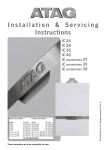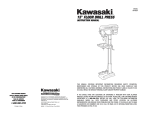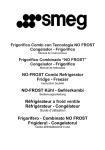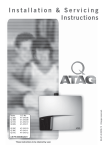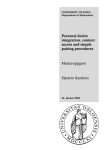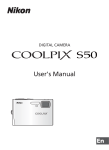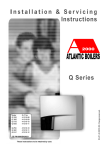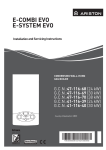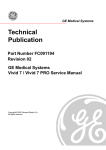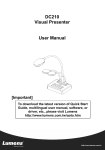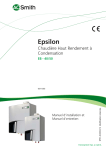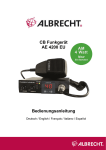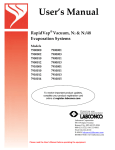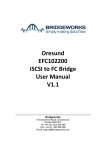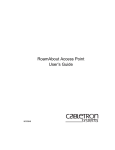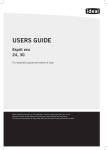Download Installing and Servicing
Transcript
Installation & Servicing Instructions iR 12 iR 15 iR 18 iR 24 iR 32 iR 40 Natural Gas Boilers Propane Gas Boilers Boiler iR 12 iR 15 iR 18 iR 24 iR 32 iR 40 Boiler iR 12 LPG iR 15 LPG iR 18 LPG iR 24 LPG iR 32 LPG iR 40 LPG G.C No 47-310-30 47-310-32 47-310-34 47-310-36 47-310-38 47-310-40 G.C No 47-310-31 47-310-33 47-310-35 47-310-37 47-310-39 47-310-41 CE PIN 0063CQ3634 These instructions are to be retained by the user. 8G.51.81.01 / 07.15 Changes reserved. E.& O. E. Open Vent System Explanation of the Control Panel & Buttons Error Error indication (accompanied with a code). Alert Service-mode or blocking Flame Visible when boiler is active for heating or DHW % bar °C + - eco reset + - Heating (OK) + (ESC) eco reset + + + - - Visible when heating program is active Flashing when there is a heat demand for heating Central heating program (On = +, Off = -) Setting of boiler temperature (max. flow temperature) +/-function (ancillary function: OK and Escape) Press 6 seconds for Information Reset button DHW button +/-function (ancillary function: Scroll and +/-function) Commissioning function (Press both + buttons for 6 seconds) See chapter 12 for more information about button functions and read-out. 2 Installation & Servicing instructions ATAG iR-Range Contents 1Introduction.....................................................................................................................................4 2 Rules & Regulations (Symbols)......................................................................................................5 3 Technical specifications...................................................................................................................7 4Dimensions ....................................................................................................................................8 5 Delivery package.............................................................................................................................9 6 Boiler description.............................................................................................................................9 7 Boiler photo components list.........................................................................................................10 8 Mounting boiler frame................................................................................................................... 11 8.1 Wall frame..........................................................................................................................12 9 Connecting boiler..........................................................................................................................13 9.1 Open vent heating system.................................................................................................13 9.2 Water quality......................................................................................................................14 9.3 Heating systems with plastic pipes....................................................................................15 9.4 Gas connection in general.................................................................................................16 9.4.1 Natural gas connection (NG).............................................................................................16 9.4.2 Propane gas connection (LPG)..........................................................................................16 9.5 Condensation drain pipe....................................................................................................18 9.6 Flue gas exhaust system...................................................................................................22 9.6.1 Flue terminal locations.......................................................................................................23 9.6.2 Dimensioning of the flue gas and air intake duct .............................................................26 9.7 Fitting the boiler onto the boiler frame..............................................................................28 10 Electrical connection.....................................................................................................................30 10.1 Electrical diagram..............................................................................................................31 11 Filling system................................................................................................................................32 12 Boiler controls...............................................................................................................................32 12.1 Controls and explanation of the functions..........................................................................33 13 Commissioning the boiler..............................................................................................................34 13.1Settings..............................................................................................................................36 13.2 Parameter chapter.............................................................................................................36 14 Isolating the boiler........................................................................................................................37 15Commissioning..............................................................................................................................38 15.1 Checking the CO2..............................................................................................................39 16 Routine servicing...........................................................................................................................41 16.1 Component replacement....................................................................................................45 16.2 User's instructions..............................................................................................................45 16.3 Maintenance frequency......................................................................................................45 16.4Warranty.............................................................................................................................45 17 Error codes and fault finding ........................................................................................................46 Annex A Annex B Annex C System water additives......................................................................................................47 Declaration of conformity...................................................................................................48 Short parts list....................................................................................................................49 Work on the installation should only be carried out by qualified personnel with calibrated equipment and appropriate tools. Installation & Servicing instructions ATAG iR-Range 3 1Introduction These instructions describe the functioning, installation, use and primary maintenance of ATAG central heating boilers for the United Kingdom. These instructions are intended for the use of Gas Safe registed installers in connection with the installation and putting into operation of ATAG boilers. It is advisable to read these instructions thoroughly, well in advance of installation. Separate instructions for use are supplied with the boiler for users of ATAG central heating boilers. ATAG is not liable for the consequences of mistakes or shortcomings which have found their way into the installation instructions or user’s manual. Further, ATAG reserves the right to alter its products without prior notification. When delivering the boiler, give the customer clear instructions concerning its use; present the customer with the user’s manual and warranty card. Each boiler is fitted with an identification plate. Consult the details on this plate to verify whether the boiler is compliant with its intended location, e.g.: gas type, power source and exhaust classification. On completion of the installation the installer or commissioning engineer must fill out and complete the Benchmark Commissioning Checklist found on page 53 of this manual and hand this to the customer for future record keeping. The Benchmark Service Record must also be completed by the service agent following each service call, and return to the customer. 4 Installation & Servicing instructions ATAG iR-Range 2 Rules & Regulations (Symbols) The following regulations apply to installation of ATAG central heating boilers: Legislation and Regulations. Gas Safety (Installation and Use). All gas appliances must by law, be installed by a competent person, eg. Members of Gas Safe Register and in accordance with the current Gas Safety Regulation. Failure to install appliance correctly could lead to prosecution. All Gas Safe registered installers carry a Gas Safe ID card and have a registration number. You can call Gas Safe Register directly on 0800 408 5577. In addition to the above regulations this appliance must be installed in compliance with the current IEE Regulations, the Building Standards (Scotland Consolidation) Regulations. Regulations and bye laws of the Local Water Authority and the Current Health and Safety Regulation. The Benchmark Scheme Benchmark places responsibilities on both manufacturers and installers. The purpose is to ensure that customers are provided with the correct equipment for their needs, that it is installed, commissioned and serviced in accordance with the manufacturer’s instructions by competent persons and that it meets the requirements of the appropriate Building Regulations. The Benchmark Checklist can be used to demonstrate compliance with Building Regulations and should be provided to the customer for future reference. Installers are required to carry out installation, commissioning and servicing work in accordance with the Benchmark Code of Practice which is available from the Heating and Hotwater Industry Council who manage and promote the Scheme. Visit www.centralheating.co.uk for more information. The current Electricity at Work Regulation must be complied with and also be in accordance with the relevant and current editions of the British Standards. The ATAG iR boiler is a certified appliance and must not be modified or installed in any way contrary to this Installation Manual. Manufacturers instructions must not be taken, in any way, as overriding statutory obligations. The ATAG iR boiler is a central heating boiler for "open" expansion tank systems (open vent) only. The boiler must be connected according to these instructions and all installation norms in respect of the part of the boiler to be connected. The appliance is not to be used by children or persons with reduced physical, sensory or mental capabilities, or lack of experience and knowledge, unless they have been given supervision or instruction. Children being supervised not to play with the appliance. Observe the following rules of safety: - All work on the boiler must take place in a dry environment. - ATAG boilers may never be in operation without their housing, except in connection with maintenance or adjustments (see Chapter 15 and 16). - Never allow electrical or electronic components to come into contact with water. Carry out the following tasks in connection with maintenance, etc. to an already-installed boiler: - Shut down all programs - Close the gas isolation valve - Shut down the 230V power supply See chapter 15 and 16 for further instructions. Installation & Servicing instructions ATAG iR-Range 5 Take note of the following when maintenance or adjustments are needed: - The boiler must be able to function during these activities; for this reason, the boiler’s 230V power supply, gas pressure and water pressure must be maintained. Ensure that there is not a source of potential danger during these activities. Following maintenance or other activities; always check the installation of all parts through which gas flows (using leak detection spray). The following (safety) symbols may be encountered in these installation instructions and on the boiler (packaging): Boiler must be stored away from frost. Protect packaging and/or contents from damage as a result of insufficient care taken during transport. Protect the boiler from weather conditions during transport and storage whilst still in its packaging. If and how to clamp when using transport trucks with clamp equipment. If and how to transport when using a rolling jack. The whole packaging is made of recycled materials and can be recycled again. Transport and place the boiler in its packaging in this position. Do not to step on or stand on the package. An assembly or dismantling must be carried out. Pay extra attention in connection with a particular operation. Useful tip or advice 6 Installation & Servicing instructions ATAG iR-Range 3 Technical specifications Technical specifications Natural gas Boiler type iR 12 iR 15 ATAG iR-Series Regular iR 18 iR 24 Type heat exchanger Input CH Net Qn Input CH Gross Modulation range CH (capacity 50/30°C) Nox class EN15502-1 O2 (at full load) iCon1 10.8 12.0 iCon1 13.5 15.0 iCon1 16.2 18.0 5.0 - 11.8 5.0 - 14.7 5.0 - 17.5 CO2 (at full load) Temperature class flue Appliance type (80/60°C C on full load) Flue gas temp. CH (80/60 Flue gas temp. CH (50/30°C on low load) Categories Gas consumption Electr. power consumption max. Electr. power consumption part load Electr. power consumption stand by Current Degree of protection acc. EN 60529 Weight boiler + jig (empty) Width Height (excl. flue) Depth Overrun time pump CH Flow temperature max. SAP Annual Efficiency NG kW kW kW % % °C C °C m3/hr W W W V/Hz 1.14 20 15 kg mm mm mm sec °C % 32 440 700 355 89.7 iCon2 36.0 40.0 5.0 - 23.2 6.9 - 31.2 6.9 - 38.8 5 4.7 3.81 46 35 35 440 700 355 89.7 0063CQ3634 Technical specifications Propane gas Boiler type Heat exchanger type O2 (at full load) % CO2 (at full load) Pre pressure Input CH Net Gas consumption Output (80/60°C) Output (50/30°C) Weight boiler + jig (empty) % mbar kW m3/hr kW kW kg iR 12 iCon1 10.8 0.45 10.7 11.8 32 ErP specifications according to European Guideline 2010/30/EU Boiler type iR 12 Seasonal space heating energy efficiency class Installation & Servicing instructions ATAG iR-Range iR 40 iCon2 28.8 32.0 9.0 T100 B23, B33, C13, C33, C43, C53, C63, C83, C93 59 59 29 30 II2H3P 1.43 1.72 2.29 3.05 23 28 36 40 17 21 27 30 4 230/50 IPX4D (B22/B33 IPX0D) 32 32 32 35 440 440 440 440 700 700 700 700 355 355 355 355 60 85 89.8 89.8 89.8 89.8 CE product identification number(PIN) Pn Power output QHE Annual energy consumption ηs Seasonal space heating energy efficiency LWA Sound power level, indoors iR 32 iCon1 21.6 24.0 kW GJ % dB iR 15 iCon1 13.5 0.56 13.3 14.7 32 iR 15 iR 18 iCon1 5.1 iR 24 iCon2 10.3 see data plate LPG 16.2 21.6 0.68 0.90 15.9 21.2 17.5 23.2 32 35 iR 18 iR 24 iR 32 iCon2 iR 40 iCon2 28.8 1.20 28.4 31.2 35 36.0 1.50 35.4 38.8 35 iR 32 iR 40 AA AA AA AA A A AA 11 3 94 37 13 4 94 37 16 5 94 43 21 7 94 46 28 9 94 48 35 12 94 54 7 4Dimensions 220 700 850 150 225 343 137 CH Return Gas CH Flow 60 220 380 440 iR 12 Flue gas / Air intake Gas connection CH Flow connection CH Return connection Condensate drain connection 8 A/B mm mm mm mm mm iR 15 ATAG iR-Series Regular iR 18 iR 24 iR 32 iR 40 60/100 22 22 22 21.5 Installation & Servicing instructions ATAG iR-Range 5 Delivery package The delivery package of the boiler is composed as follows: - Boiler frame; - Boiler with cover; - Automatic air vent (in boiler); - Isolation valves with drainpoint (CH 2x) - Gas isolating valve; - Fittings consisting of plugs and screws; - Drawing template; - Installation instructions; - User manual; - Warranty Card. The following components are not present in the boiler packaging as a standard and should be included in the installation according to the requirements: - Flue system; - External controls. 6 Boiler description The ATAG iR is a room sealed, condensing and modulating CH boiler for "open" expansion tank systems (open vent) only. The boiler is equipped with a compact stainless steel heat exchanger with smooth pipes. It is a well thoughtout principle using sustainable materials. The boiler burns gas to supply heat (natural gas and LPG versions available). This heat is transferred in the heat exchanger to the water in the CH installation. The rapid cooling off of the flue gases causes condensation. This results in a very high efficiency. The condensate that is formed, has no negative impact on the heat exchanger and it's operation, and is removed through the internal siphon. This feature requires a condensate drain pipe connected to the drain of the building. The boiler is equipped with an intelligent control system. The boiler anticipates on the heat demand of the heating installation or hot water demand. This will cause the boiler to tune its capacity to the installation. This means that the boiler will function longer and at a low level. The boiler has been tested according to valid CE standards and has a CE certificate and >88% Efficient SEDBUK 2009. Statement: No banned materials including asbestos, mercury, CFC's have or will not be included in the product. Installation & Servicing instructions ATAG iR-Range 9 7 Boiler photo components list 9 10 5 3 6 1 2 T1 11 T2 4 8 7 12 13 14 15 A G R C F1 ATAG iR 1 2 3 4 5 6 7 8 10 Heat exchanger Ignition unit Fan unit Air supply damper Gas valve Automatic de-aerator Control unit Control panel 9 Flue gas exhaust 10 Combustion air supply 11 Boiler data plate 12Siphon 13 Isolation valve flow CH 14 Isolation valve gas 15 Isolation valve return CH Figure 7.a T1 T2 F1 G A R C Flow sensor Return sensor Flow switch Gas pipe Flow pipe CH Return pipe CH Condensation pipe Installation & Servicing instructions ATAG iR-Range 8 Mounting boiler frame Install the boiler in a boiler room in accordance to the actual local regulations BS5440-2:2000. The installation location of the boiler has to be, and remain, frost-free. The boiler casing is splash water tight (IPX4D) and is suitable to be installed in e.g. a bathroom. It is NOT necessary to have a purpose provided air vent in the room or internal space in which the boiler is installed. Neither is it necessary to ventilate a cupboard or compartment in which the boiler is installed, due to the extremely low surface temperature of the boiler casing during operation. Therefore the requirements of BS 6798, Clause 12, and BS5440:2 may be disregarded. The boiler can be mounted practically to any wall with the wall frame and the enclosed fixing equipment. The wall must be flat and of sufficient strength in order to be able to carry the boiler weight with its water content. Above the boiler there must be at least 175 mm working space in order to be able to fit a horizontal concentric flue system to the rear (See chapter 9.6 for more flue options). Make sure there is sufficient service space arround the boiler according figure 8.a. The location of the boiler can be determined by using the template. The wall frame allows the possibity to pre-fit the complete heating system before fitting the boiler. Also the flue system can be prepared. Finally fitting of the flue system is done after fitting the boiler. See next page for all options for connection the heating, condensate, flue and gas installation. Before hanging the boiler to the boiler frame remove the front panel of the boiler first. The front panel is also the air cabinet and is attached to the boiler case with 2 fasteners (A and B) (see figure 8.a). Note that there is an earth cable to disconnect when removing the boiler front panel. Free space for removing the connector is about 400 mm. Remember to connect this earth cable when placing back the boiler front panel and take care the wire does not get stuck between front panel and boiler. 175 400 2.5 2.5 Bayonet catch A B 100 Service space Service space Service dimensions (in mm)Figure 8.a See chapter 9.8 for further procedure to fit the boiler onto the boiler frame. Installation & Servicing instructions ATAG iR-Range 11 8.1 Wall frame - - - - - Position the boiler frame against the wall using the template and a level. Use the level for horizontal positioning and checking the vertical position. Drill 4x ø10mm holes, 60mm deep Press the nylon wall plug (ø10x55mm) in the holes Mount the boiler frame to wall with the 4 coach screws (ø8x60mm) using a 13mm wrench The boiler frame allows pipe work to be installed behind the boiler. The pipe work must be installed at least 10mm inside the front of the frame. ATAG i-Serie template and boiler frame 12 Figure 8.1.a Installation & Servicing instructions ATAG iR-Range 9 Connecting boiler The boiler has the following connection pipes; - The central heating pipes. The boiler is provided with isolation valves on the flow and return pipe to which the installation can be connected by means of 22mm compression fittings; - The gas pipe. The boiler is provided with an isolation gas valve to which the gas line can be fitted with 22mm compression fitting; - The condensation drain pipe. It consists of a 25mm flexible plastic pipe. The drain pipe can be connected to this by means of an open connection; - The flue gas exhaust system and air supply system. It consists of a concentric connection 60/100 mm. See following chapters for detailed information regarding each connection. It is advisable to clean all of the boiler’s connecting pipes and/or to power flush the installation before connecting it to the boiler. 9.1 Open vent heating system This boiler is only suitable for installations that have been equipped with “open” expansion tanks (open vent). Connect the central heating system according to the current regulations. DHW cylinder 22 mm (Min.) Automatic by-pass 22 mm (Min.) vent feed and expansion cistern 1000 mm Min. 15 mm (Min.) cold feed Open vent heating system Recommended relationship between pump, cold feet and vent. 450 mm Min. height Heating circuit Pump Boiler 150 mm Max. Scheme open vent system Installation & Servicing instructions ATAG iR-Range Figure 9.1.a 13 The boiler pipes can be connected to the installation by means of 22mm compression fittings. For connecting to thick-walled pipe (welded or fitted), adapters should be used. The boiler is NOT equipped with a built-in internal filter. Advice: ATAG Heating Technology Ltd recommend the installation of an in-line filter installed into the heating return as close to the boiler as possible. ATAG Heating Technology Ltd recommend the use of the: ATAG iGuard Magnetic filter 22mm (Brass) FC000200 (5 year warranty) Additives in the installation water are only permitted in consultation with the country distributor. See chapter 9.2 for detailed information. 9.2 Water quality Fill the installation with mains cold water. In most cases, a heating system can be filled with water according to national standards for water and treatment of this water is not necessary. In order to avoid problems with the CH-installations, the quality of the filling water has to meet the specifications mentioned in table 9.2.a: If the filling water does not meet the required specifications, you are advised to treat the water to such an extent that it does meet the required specifications. The warranty becomes invalid, if the installation is not being flushed and/or the quality of the filling water does not meet the specifications recommended by ATAG Heating Technology Ltd. Always contact ATAG Heating Technology Ltd in advance, if things are not clear or you wish to discuss any deviations. Without approval, the warranty becomes invalid. Installation: - The use of groundwater, demi-water and distilled water is prohibited. (on the next page you will find an explanation of these definitions) - If the mains water quality meets the specifications mentioned in table 9.3.a, you can start flushing the installation before installing the device. - Whilst flushing, corrosion products (magnetite), fitting products, cutting oil and other undesirable products have to be removed. - Another possibility is to remove the pollution by installing a filter. The filter type has to fit the type and grain size of the pollution. ATAG Heating Technology Ltd recommends filter usage. - In this case, the whole piping system should be taken into consideration. - The CH-installation has to be properly vented before using the system. For that purpose, we refer to the commissioning chapter. - If a regular water top up is required (>5% on an annual basis), then there is a structural problem and an installer has to solve the problem. Regularly adding fresh water to the system also adds additional calcium and oxygen implying that magnetite and calcium residues can continue. The result may be blockages and/or leakages. - The use of anti-freeze and other additives requires periodical quality checks of the filling water in accordance with the period laid down by the additives supplier. - Chemical additions are to be avoided and should only be used after ATAG Heating Technology Ltd has approved their corresponding use. - Should you wish to achieve the required water quality by using chemical additives, then this is your own responsibility. The warranty on the product delivered by ATAG Heating Technology Ltd expires, if the water quality does not meet ATAG Heating Technology's specifications or the chemical additives have not been approved by ATAG Heating Technology Ltd. - On installation and during additions or changes at a later stage, ATAG Heating Technology Ltd recommends to keep a record of the type of water used, its quality at the time, and if applicable, which additives and quantities were added. 14 Installation & Servicing instructions ATAG iR-Range Parameter Value Water type Potable water Softened water pH 6.0-8.5 Conductivity (at 20°C in µS/cm) Max. 2500 Iron (ppm) Max. 0.2 Hardness (°dH / ppm): Installation volume/capacity 1-12 °dH / 17-214 ppm <20 l/kW Installation volume/capacity 1-7 °dH / 17-125 ppm >=20 l/kW Oxygen No oxygen diffusion allowed during operation. Max. 5% filling water addition annually Corrosion inhibitors Refer to Additives Attachment pH increasing or lowering agents Refer to Additives Attachment Anti-freeze additives Refer to Additives Attachment Other chemical additives Refer to Additives Attachment Solid substances Not allowed Residues of processing water not forming part of the drinking water Not allowed table 9.2.a Water type definition: Potable water: Tap water compliant with the European drinking water guideline: 98/83/EG dated 3 November 1998. Softened water: Water with partly de-ionised calcium and magnesium. Demi-water: Virtually completely demineralised water (very low conductivity) Distilled water: Water no longer containing minerals. 9.3 Heating systems with plastic pipes When connecting or using an underfloor heating system, designed with plastic pipes, or plastic pipes are used elsewhere in the installation, one should ensure that the plastic pipes used comply with the DIN 4726/4729 standard. It is set out in this standard that the pipes may not have oxygen permeability higher than 0.1 g/m³.d at 40°C. If the system does not comply with this DIN standard, the underfloor heating component will have to be separated from the central heating appliance by means of a plate exchanger. No recourse can be made to the terms of the warranty in the event of failure to observe the regulations pertaining to plastic underfloor heating pipes. Installation & Servicing instructions ATAG iR-Range 15 9.4 Gas connection in general The local gas supplier should be consulted, at the installation planning stage, in order to establish the availability of an adequate supply of gas. An existing service pipe must NOT be used without prior consultation with the local gas supplier. ATAG supplies boilers suitable for natural gas only and boilers for LPG only. Verify the identification plate on the boiler if the boiler is suitable for the gas kind on site. The boilers cannot be converted to another kind of gas. Make sure that the gas pipe work does not contain dirt, particularly with new pipes. The complete installation MUST be tested for gas tightness and purged as described in the above code. The boiler connection is provided with an isolation valve with 22mm compression fitting, into which the gas line can be fitted. 9.4.1 Natural gas connection (NG) The gas supply must comply to the current Gas Safety, Installation & Use Regulations, in accordance with BS.6891. The nominal inlet working gas pressure measured at the appliance should be 21 mbar +/- 2 mbar for Nat gas (G20). Allowing for the acceptable pressure loss of 1 mbar across the installation pipework, it can be assumed that a minimum permitted operating pressure of 18 mbar will be delivered to the inlet of the appliance. (Reference BS 6400-1 Clause 6.2 Pressure Absorption). When tested at the gas valve, the pressure drop from the meter to the gas valve must not be more than 3.8 mbar. 9.4.2 Propane gas connection (LPG) The LPG installation has to comply with British Standard 813 and Domestic Gas Installations Installing of a LPG installation should only be done by a registered LPG installer. The tank must be provided with a high pressure regulator with a minimum capacity of 24 kg/h to reduce the tank pressure from 5 to 1.5 bar. The 1.5 bar high pressure gas line should have a minimum diameter of 15mm. In the high pressure gas line a house pressure regulator must be installed. When tested at the gas valve, the pressure drop from the pressure regulator to the gas valve must not be more than 3.7 mbar. 16 Installation & Servicing instructions ATAG iR-Range 9.4.3 House pressure regulator Each gas appliance which is connected to the propane installation must be provided with its own house pressure regulator. The house pressure regulator is a third party delivery. The house pressure regulator must have a minimum capacity of 10 kg/h / 30 mbar and a CE certification. ATAG advices to install the house pressure regulator as close as possible to the boiler. When placing the regulator inside, a discharge drain of ø6mm must be installed. The discharge drain must be directed outdoor. In case of a discharge the gasses will go outside. If fitting the regulator outside the regulator should be protected against influences of the weather. The (de-) aeration must be positioned downwards (see figure 9.5.3.a). ATAG advices to install measure points on all gas line parts to have the possibility to check for pressure loss. example propane installation figure 9.4.3.a Pre-pressure must be adjusted to 30 mbar by means of the house pressure regulator. The maximum permitted closing pressure may be 5 mbar higher than the maximum pre-pressure. A too high closing pressure in the low pressure gas line can be caused by a high resistance or jam in this gas line. When the closing pressure keeps increasing the valve in the regulator is not closing correctly. In this case the regulator should be replaced. 9.4.4 Dimensioning of the low pressure gas line The gas line from the house pressure regulator to the boiler must have the dimensions according the table below. Boiler type Diameter gas line ø15mm ø22mm ø28mm iR 12 m 3 30 - iR 15 m 18 30 iR 18 m 18 30 iR 24 m 18 30 iR 32 m 18 30 iR 40 m 18 30 9.4.5 De-aerating the LPG tank When placing a new or revised LPG tank the tank must alway be de-aerated. ATAG advices to inform the gas supplier that a central heating boiler is connected to the LPG tank. For the boiler it is absolutly necessary that the tank is free of air. When not the boiler will give ignition problems and will not function. ATAG advices to measure the content of O2 . This value should be lower than 1.3%. Contact the gas supplier in case of doubt. Installation & Servicing instructions ATAG iR-Range 17 9.5 Condensation drain pipe The ATAG condensing boiler has the >88% Efficient SEDBUK 2009 for high energy efficiency in heating and domestic hot water. The ATAG wall hung gas fired condensing boiler contain a siphonic condensate trap to collect and realease condensate. The amount of condensate formed is determind by the type of boiler and the water temperature produced by the boiler. Condensate pipework. Use plastic pipework of an internal diameter no less then 19mm ID (typically 22mm OD). Routing of the pipework, The condensate pipework must fall at least 45mm per metre away from the boiler, taking the shortest practicle route to the termination point. Support the pipe at least every 50 cm for near horizontal sections and 1 metre for vertical sections. Wherever possible, the condensate pipework should be routed internally to prevent freezing. In order to minimise the risk of freezing during prolonged very cold spells, one of the following methods of terminating condensate drainage pipe should be adopted. Internal pipework Wherever possible, the condensate drainage pipe should be terminated at a suitable internal foul water discharge point such as (a) an internal soil and vent stack or (b) an internal kitchen or bathroom waste pipe, washing machine waste pipe etc. A suitable permanent connection to the foul waste pipe should be used. Figures 9.5.1, 9.5.2(a), 9.5.2(b) show appropriate connection methods. The possibility of waste pipes freezing downstream of the connection point should be considered when determining a suitable connection point - e.g. a slightly longer pipe run to an internal soil stack may be preferable to a shorter run connecting into a kitchen waste pipe discharging directly through the wall to an external drain. Where “gravity discharge” to an internal termination is not physically possible (e.g. the discharge point is above the appliance location, or access is obstructed by a doorway), or where very long internal pipe runs would be required to reach a suitable discharge point, the following measures may be adopted. Use of a condensate pump (to an internal termination): Condensate can be removed using a proprietary condensate pump (third party delivery), of a specification recommended by the pump manufacturer. The pump outlet should discharge to a suitable internal foul water discharge point, such as (a) an internal soil and vent stack or (b) an internal kitchen or bathroom waste pipe, washing machine waste pipe etc. Figure 9.5.3 shows a typical connection method. A suitable permanent connection to the foul waste pipe should be used and the manufacturer’s detailed installation instructions for the pump should be followed. 18 Installation & Servicing instructions ATAG iR-Range 1 2 3 4 5 6 7 8 Boiler Visible air break 75mm trap Visible air break and trap is not required because there is a trap with a condensate seal of 180mm incorporated into the boiler (minimum requirement is 75mm) Soil and vent stack Invert 450mm minimum up to three storeys Minimum internal diameter 19mm (fall at least 45mm per meter) Drain requirements 1 2 3 4 5 6 7 8 9 Figure 9.5.1 Boiler Visible air break at plug-hole 75 mm sink, basin, bath or shower waste trap Sink, basin, bath or shower with integral overflow Open end of condensate drainage pipe direct into gully 25mm min below grating but above water level; end cut at 45° Minimum internal diameter 19mm (fall at least 45mm per meter) Pipe size transition Minimum internal diameter 30mm Water/weather proof insulation Drain requirements Installation & Servicing instructions ATAG iR-Range Figure 9.5.2 (b) 1 2 3 4 Boiler Visible air break 75mm trap Visible air break and trap is not required because there is a trap with a condensate seal of 180mm incorporated into the boiler (minimum requirement is 75mm). In this case the 100mm is measured to the trap in the boiler. 5 Sink, basin, bath or shower 6 Open end of condensate drainage pipe direct into gully 25mm min below grating but above water level; end cut at 45° 7 Sink lip 8 Minimum internal diameter 19mm (fall at least 45mm per meter) 9 Pipe size transition 10 Minimum internal diameter 30mm 11 Water/weather proof insulation Drain requirements 1 2 3 4 5 Figure 9.5.2 (a) Condensate discharge from boiler Condensate pump Visible air break at plug hole Sink or basin with integrated overflow 75mm sink waste trap Drain requirements Figure 9.5.3 19 External pipework The use of an externally-run condensate drainage pipe, terminating at a suitable foul water discharge point or purpose-designed soakaway, may be also be considered; however if this termination method is chosen then the following measures should be adopted - The pipe should be run internally as far as possible before going externally and the pipe diameter should be increased to a minimum of 30mm ID (typically 32mm OD) before it passes through the wall. - The external run should be kept as short as possible, taking the most direct and “most vertical” route possible to the discharge point, with no horizontal sections in which condensate might collect. Do not exceed 3 metres outside the dwelling. - The external pipe should be insulated using suitable waterproof and weatherproof insulation (“Class O” pipe insulation is suitable for this purpose) . - The use of fittings, elbows etc should be kept to a minimum and any internal “burrs” on cut pipework should be removed so that the internal pipe section is as smooth as possible. The customer/householder should be advised that even with the above measures this type of installation could freeze, and that if this were to occur then boiler shutdown could result, requiring remedial action possibly involving a chargeable engineer call-out. Where there are likely to be extremes of temperature or wind-chill, the use of a proprietary trace-heating system for external condensate drainage pipework, incorporating an external frost thermostat, should therefore be considered. If such a system is used then the installation instructions of the trace heating manufacturer and any specific recommendations regarding pipe diameter, insulation, etc. should be followed. All other relevant guidance on condensate drainage pipe installation should also be followed. Other cold weather protection methods approved or endorsed by boiler manufacturers and/or service organisations may be adopted if these are considered suitable by the parties involved. If an external soil/vent stack is used as the external termination then the connection method shown in Figure 9.5.4 should be used, together with the measures on insulation etc. as described above and shown in the diagram. When a rain water downpipe is used as the termination (NB only permissible if this downpipe passes to a combined foul and rainwater drainage system) an air break must be installed between the condensate drainage pipe and the downpipe to avoid reverse flow of rainwater into the boiler should the downpipe itself become flooded or frozen. Figure 9.5.5 shows a suitable connection method. Where the condensate drainage pipe is terminated over an open foul drain or gully, the pipe should terminate below the grating level, but above water level, in order to minimise “wind chill” at the open end. Pipe drainage will be improved if the end is cut at 45° as opposed to a straight cut. The use of a drain cover (such as those used to prevent blockage by leaves) may offer further protection from wind chill. Figure 9.5.6 shows a suitable connection method. Where the condensate drain pipe terminates in a purpose-designed soakaway (see BS 6798:2009 or boiler installation manual for soakaway design requirements) any above-ground section of condensate drainage pipe should be run and insulated as described above. Figure 9.5.7 shows a suitable connection method. Unheated internal areas: Internal condensate drainage pipes run in unheated areas such as lofts, basements and garages should be treated as external pipe. Draining of the condensation water to the external rain guttering is not permitted in view of the danger of freezing. Before putting the boiler into operation fill the siphon with 150 ml of water. 20 Installation & Servicing instructions ATAG iR-Range 1 2 3 4 Boiler Visible air break 75mm trap Visible air break and trap is not required because there is a trap with a condensate seal of 180mm incorporated into the boiler (minimum requirement is 75mm) 5 Soil and vent stack 6 Invert 7 450mm minimum up to three storeys 8 Minimum internal diameter 19mm (fall at least 45mm per meter) 9 Pipe size transition 10 Minimum internal diameter 30mm 11 Water/weather proof insulation Drain requirements Figure 9.5.4 1 2 3 4 Boiler Visible air break 38mm minimum trap Visible air break and trap is not required because there is a trap with a condensate seal of 180mm incorporated into the boiler (minimum requirement is 38mm) 5 External length of pipe 3m maximum 6 Open end of condensate drainage pipe direct into gully 25mm min below grating but above water level; end cut at 45° 7 Minimum internal diameter 19mm (fall at least 45mm per meter) 8 Pipe size transition point 9 Minimum internal diameter 30mm 10 Water/weather proof insulation Drain requirements Installation & Servicing instructions ATAG iR-Range Figure 9.5.6 1 Condensate discharge pipe from boiler 2 Pipe size transition point 3 Water/weather proof insulation 4 43mm 90° male/female bend 5 External rain water pipe into foul water 6 External air break 7 Air gap 8 68 mm ø PVCu strap-on fitting 9 Minimum internal diameter 19mm 10 Minimum internal diameter 30mm 11 End cut at 45° Drain requirements Figure 9.5.5 1 Condensate discharge pipe from boiler 2 Ground (this section of the condensate drainage pipe may be run either above or below ground level); End cut at 45° 3 Diameter 100mm minimum plastic tube 4 Bottom of tube sealed 5 Limestone chippings 6 Two rows of three 12mm holes at 25mm centres, 50mm from bottom of tube and facing away from house 7 Hole depth 400mm minimum by 300mm diameter 8 Minimum internal diameter 19mm (fall at least 45mm per meter) 9 Pipe size transition point 10 Minimum internal diameter 30mm 11 Water/weather proof insulation Drain requirements Figure 9.5.7 21 9.6 Flue gas exhaust system The flue gas exhaust system and air supply system consists of: - Flue gas pipe; - Air supply pipe; - Roof or wall terminal. The flue gas exhaust system and air supply system must comply with: The flue gas outlet and air supply installation must comply with the current regulation requirements. IG UP 10 and BS 715. The ATAG iR boiler as described in this manual is NOT suitable for a combined flue system. The appliance concentric connection diameter is 60/100 mm, to which the flue gas outlet and air supply system can be fitted, with or without elbow pieces. The maximum permissible pipe length is set out in Table 9.6.2.a. For further information about the available components of the flue gas and air supply system we recommend you consult the Flue system literature. Combinations with other brands or systems are, without written permission from ATAG Heating, not permitted. The ATAG flue gas system is meant, and designed, solely for the use on ATAG central heating boilers adjusted to Nat gas or LPG. For this purpose the CE Certificate has been supplemented under the Gastec nr: 0063CQ3634 The maximum flue gas temperatures are below 70°C (full load 80/60°C). The proper operation may be adversely influenced by changes of or adjustments to the correct set up. Possible warranty claims will not be honoured if incorrect changes result in non compliance with the installation manual or local rules and regulations. Room sealed system P/A Boiler Class C Permitted only when the air intake and the flue gas outlet are in the same pressure area. LEGEND: P/A Polypropylen / Aluminium P/A Room sealed system 22 P/A P/A Figure 9.6.a Installation & Servicing instructions ATAG iR-Range 9.6.1 Flue terminal locations The terminal should be located where dispersal of combustion products is not unimpeded and with due regard for the damage or discolouration that might occur to parts of the building in the vicinity (see fig 9.6.1.c). In certain weather conditions condensation may also accumulate on the outside of the air inlet pipe. Such conditions must be considered and where necessary insulation of the inlet pipe may be required. In cold and/or humid weather water vapour may condense on leaving the flue terminal. The effect of such ‘plumeing’ must be considered. The terminal must not be located in a place where it is likely to cause a nuisance. For protection of combustibles, refer to IS 813 section 9.10.1. where the terminal is less than 2m (6.6ft) above a pavement or platform to which people have access (including) any balcony or flat roof. The terminal must be protected by a guard of durable material. Where a terminal is fitted below a window which is hinged at the top, and where the hinge axis is horizontal, and the window opens outwards, the terminal shall be 1m below the bottom of the window opening. If the boiler is to be located under stairs, a smoke alarm meeting the requirements of I.S. 409 or equivalent must be fitted. The flue must be terminated in a place not likely to cause a nuisance. For horizontal flue terminal direct to the rear or side through the wall (only 1 bend and 1 wall terminal) the terminal should be placed horizontal. The flue pipe inside the terminal is fitted in a 3 degrees angle to ensure the condensation water can run back to the boiler. See figure 9.6.1.a. For longer horizontal sections, the outlet system should always be fitted on an incline (52 mm/m = 3°) sloping down towards the boiler so that no condensation water is able to accumulate in the outlet system. The chances of icicles forming on the outlet is minimised by causing the condensation water to run back towards the boiler. See figure 9.6.1.b. Figure 9.6.1.a Elbow or vertical adapter Maximum straight length: 13m: iC 24/28 6m: iC 36/40 iR 12/15/18/24 iR 32/40 iS 12/15/18/24 iS 32/40 3° 89mm 1m 141mm 194mm 246mm 299mm 351mm 403mm 456mm 508mm 560mm 612mm 664mm 2m 3m 4m 5m 6m 7m 8m 9m 10m 716mm 11m 12m Installation & Servicing instructions ATAG iR-Range Figure 9.6.1.b 23 Q N N P P O S S N J C J B J O B A O P R G K L F T E I A N J H M D N T G G M G G F T L L K Boundary Boundary Terminal Building 600mm Terminal facing the boundary Terminal parallel to the boundary Adjacent building Boundary Building 300mm 600mm Min. distance (mm) A Directly below an opening, air brick, windows, etc. B Below gutters, soil pipes or drain pipes 75 (See Note 3) C Below eaves 200 (See Note 3) Building D Below balconies 200 (See Note 3) From a vertical drain pipe or soil pipe 150 (See Note 3) 300 (See Note 2) F From an internal or external corner Above ground, roof or balcony level H From a surface or boundary facing the terminal I From a terminal facing the terminal J Above an opening, air brick, window etc. K Vertically from a terminal on the same wall L Horizontally from a terminal on the same wall M Horizontally from an opening, air brick, window etc. 2000mm Terminal Terminal facing an opening in adjacent building Figure 9.6.1.c 300 (See Note 1) E G Terminal Window Boundary Terminal Terminal at an angle to the boundary Terminal position 300mm Building 300 600 (See Note 4) 1200 300 (See Note 1) 1500 300 300 (See Note 1) N Minimum protrusion through a roof 300 O From a vertical obstruction 300 P From an openable window 600 Q From an adjacent vertical terminal 600 R From an opening in the car port (e.g. door, window) into the dwelling 1200 S Below a roof window 2000 T Terminal parallel to a boundary 300 Notes: 1. In addition, the terminal should not be nearer than 150mm to the framework of an opening into the building, i.e. a window surround or door surround. 2. This clearance may be reduced to 25mm without effecting the performance of the boiler. However, to ensure the condensate plume does not affect adjacent surfaces a clearance of 300mm is preferable. 3. These clearances may be reduced to 25mm without effecting the performance of the boiler. However, to ensure the condensate plume does not affect adjacent surfaces the terminal can be extended beyond gutters, pipes, eaves, balconies etc. by up to 500mm. If the flue is extended more than 500mm outside, it should be boxed and insulated. 4. To reduce the possibility of nuisance to neighbouring buildings etc. it is recommended the terminal should not be less than 2500mm from car parking spaces, building boundary walls, fences etc. 5. A terminal must not be sited under a car port roof. 6. In certain weather conditions the terminal will emit a plume of steam. If possible avoid positioning the terminal where this may cause a nuisance, i.e. positions A, D, G, H, J or M. 7. The flue terminal must be exposed to the external air and the position must allow the free passage of air across it at all times. 8. A terminal must not be sited below 2m where people have access to, such as public footpaths, access routes, patios etc. However, If the terminal is fitted less than 2m above a surface where there is no public access, the terminal must be protected by a terminal guard. 24 Installation & Servicing instructions ATAG iR-Range The appliance produces a white wisp of condensate (plumeing). This wisp of condensation is harmless, but can be unattractive, particularly in the case of outlets in outside walls. For wall terminals a plume management kit is available as an option (see fig. 9.8.1.d). Plume management kit Figure 9.6.1.d 3 1200 5 4 200 300 balcony 150 300 200 window 2 150 300 25 300 door 150 200 window 150 window 150 150 drainpipe 1 100 200 300 25 200 600 6 boundary 1000 Figure 9.6.1.e Terminal position Plume Management Kit (mm) 1 Clearance no less than 200 mm from the lowest point of the balcony or overhang. 2 1,200 mm from an opening in a car port on the same wall i.e. door or window leading into dwelling. 3 The flue cannot be lower than 1,000 mm from the top of the light well due to the build up of combustion products. 4 1,200 mm between air intake and facing terminal. 5 Internal/external corners. The air intake clearance can be reduced to 150 mm providing the flue exhaust outlet has a 300 mm clearance. 6 600 mm distance to a boundary or surface facing a boundary, unless it will cause a nuisance. BS 5440: Part 1 recommends that care is taken when siting terminals in relation to boundaries. Notes: 1. 2. 3. 4. See also Notes on previous page. Plume kits running horizontally must have a 10° fall back to the boiler for proper disposal of condensate. For details on specific lengths see relevant chapter Dimensioning of the flue gas and air intake duct. A terminal must not be sited under a car port roof. Installation & Servicing instructions ATAG iR-Range 25 9.6.2 Dimensioning of the flue gas and air intake duct The total length of the run of the flue is determined by the flue diameter, including for the connection pipe, elbows fittings and terminal covers etc.. An incorrect dimensioned flue system can lead to disorders. Look at table 9.6.2.a for the choice of the boiler and the corresponding maximum flue lenght. Explanation table 9.6.2.a: Concentric flue gas system: maximum noted length L = distance between boiler (from elbow or vertical adapter) and the end of terminal When using bends the noted value behind every bend should be deducted from the maximum straight length. Concentric flue system ø60/100mm L iR 12 iR 15 iR 18 iR 24 Example: An iR24 with a concentric flue gas system ø60/100mm has according to the table a maximum flue straight length of 13m In the system that is going to be put in there are 2 x 45° bends, so the maximum flue gas length is 13 – ( 2 x -1.0 ) = 11 m. iR 32 iR 40 ø60/100mm Maximum straight length 60/100 87° bend resistance length 45° bend resistance length Maximum straight length 60/100 87° bend resistance length 45° bend resistance length Dimensions flue gas system and air supply system L in m 13 1.6 1.0 6 1.6 1.0 Table 9.6.2.a Flue dimensions Rear Flue B (mm) Telescopic flue (FA100100) Side Flue Min Max 280 430 B + C (mm) Telescopic flue (FA100100) Min Max 285 435 Rear Flue L = wall thickness (B) + 150mm L Side Flue L = wall thickness (B) + distance between boiler and wall (C) + 150mm If the length L is more than 580mm rear flue or 585mm side flue, then a Horizontal flue fixed length 1000mm (60/100mm) with lock function elbow (FA100250) will need to be used instead, up to 810mm. Figure 9.6.2.a 26 Installation & Servicing instructions ATAG iR-Range Fitting the flue Note: If it is required to cut an extension, DO NOT cut the end of the inner duct that incorporates the seal joint. Ensure the inner duct end without the seal joint is cut so that it is flush with the outer duct. Ensure that all cuts are square and free from burrs. Once assembled with the components pushed home, the flue is fully sealed. 1. Adjust the telescopic flue and secure with sealing tape supplied or cut the fixed length terminal flue to the required length. 2. Fit the flue to the extensions (if required) by locating the inner duct into the seal joint and push fully home the inner and outer duct. 3. When connecting the horizontal flue terminal length ensure the terminal end outlet is at the uppermost part of the flue. 4. Pass the terminal flue assembly through the wall. 5. Fit the bend to the boiler and rotate to the correct position and secure in position. 6. If the inside sealing collar (white) is being used to make good the inside wall, then it will need to be fitted before assembling the flue. 7. Pull the flue assembly towards the bend, locating the inner duct into the seal joint on the bend and secure the flue assembly to the bend by pushing fully home. 8. Make good the outside wall by fitting the outside sealing collar (grey) onto the location provided immediately behind the flue terminal grille. Make good the inside wall using the inside sealing collar (white) if required. When mounting the flue gas system, pay attention to the flow direction (See figure 9.6.2.b). It is not permitted to mount a system upside down and will lead to complaints. Use a soap solvent or special grease (supplied in the accessory bag with the boiler) to simplify the fitting. Flue Air Air The ATAG flue system used is a push fit flue system, which does not require screws to be fitted at each flue joint. The flue system must be adequately supported at regular intervals between brackets of no more than 1.0 metres for horizontal sections and no more than 2.0 metres for vertical sections. Installation & Servicing instructions ATAG iR-Range Flow direction Figure 9.6.2.b 27 9.7 Fitting the boiler onto the boiler frame After the pipe work of gas, heating installation installation has been fitted to the boiler frame, the boiler can be placed on the boilerframe. Before hanging the boiler to the boiler frame remove first the cover of the boiler first. The cover is also the air cabinet and is attached to the boiler case with 2 fasteners (A and B) (see figure 8.a). Note that there is an earth cable to disconnect when removing the cover from the boiler. Free space for removing the connector is 400mm. Remember to connect this earth cable when replacing the cover. Always secure the fasteners with the screws (A and B) after replacing the cover. Remove furthermore the 4 plastic caps from the boiler connections. When removing the plastic sealing caps from the pipes, contaminated testing water may be released. Lift the boiler only by the boilers case. Lifting and carrying precautions: - Lift only a manageable weight, or ask for help. - When lifting the boiler, bend the knees, and keep the back straight and feet apart. - Do not lift and twist at the same time. - Lift and carry the boiler close to the body. - Wear protective clothing and gloves to protect from any sharp edges. Bottom of boiler Jig nuts 1 2 Figure 9.7.a 1. Press all connection underneath the boiler upwards 2. Put on each valve and the elbow fitting a fibre washer (supplied) ± 50mm 2 3 4 Figure 9.7.b 3 and 4. Take the boiler and hang it from approx. 50mm higher than the boiler frame vertical downwards on the boiler frame so the fittings will be axial approached. 28 Installation & Servicing instructions ATAG iR-Range Figure 9.7.c Fitting the nuts: Turn each nut of the fittings on the boiler connections by hand and tighten each nut with a wrench. Note: 1/2" with 25Nm and 3/4"with 40Nm. 2 9 1 7 6 8 5 4 3 Figure 9.7.d Fitting siphon: - Press and turn the assembly (3), with the elbow first, in the corresponding holes in the bottom plate of the boiler. - Press the black rubber elbow with flexible drain pipe (1) on the condensate tray (2). - Press the black flexible pipe (1) from inside the boiler in the rubber T-piece (3). - Press the black rubber plug (9) from inside the boiler in the rubber elbow of assembly (3). - Lead the long black flexible pipe (4) through the free hole of the boiler frame and press it in the T-piece (3) - Lead the other end of the flexible pipe outside the boiler to the drain as installed according to chapter 9.7. - Fill the siphon cup (5) with 150 ml water, insert the siphon pipe (6) in the siphon cup (do not press) and insert this through the hole in the bottom plate of the boiler into the condensate tray (2) of the heat exchanger without any force. Secure the siphon cup with the securing clip (7) by turning it clockwise (click!). - Press the sealing ring (8) around the siphon cup and press/turn it in the bottom plate of the boiler. Before putting the boiler into operation fill the siphon with 150 ml of water. Installation & Servicing instructions ATAG iR-Range 29 10 Electrical connection The appliance complies with the actual directives. The installation must continue to comply with: - A 230V -50Hz mains electrical supply is required fused externally at 3A. - A deviation on the grid of 230V (+10% or -15%) and 50Hz - the national rules for electrical installations. The appliance must be connected to an earthed socket. This must be visible and within reach. The following general stipulations also apply: - No changes may be made to the wiring of the appliance; - All connections should be designed in accordance with the enclosed regulations; - Should it be necessary to change it, the mains power supply cable may only be replaced with an ATAG mains power supply cable. The connection terminals are positioned at the back of the control unit: - Press handle A slightly to the left (see fig. 10.a) - Turn the control unit downwards. 230V control terminal block iR-Range SwL: Switched live 230V live input only! L L:Live N 230V out 230V Control A SwL N:Neutral E E:Earth L’ L': Live pump N N': Neutral pump E E': Earth pump 230V live output 230V live output to pump n.a. = not applicable n.a. = not applicable n.a. = not applicable n.a. = not applicable n.a. = not applicable n.a. = not applicable DO NOT CONNECT 230VOLT Terminal block iR-Range terminal block 30 Figure 10.a Installation & Servicing instructions ATAG iR-Range Installation & Servicing instructions ATAG iR-Range 1 0K 9. RETURN SENSOR T2 23. FLOW SCHWITCH CH 1 0K 8. FLOW SENSOR T1 1 2 3 X13 1 2 3 1 2 3 4 5 6 7 1 2 3 4 5 6 X1 X2 X4 X17 black T 3,15 H 21. FUSES 250V T 3,15 H HIGH VOLTAGE (230V) ATAG iR-Series LOW VOLTAGE X6 X5 9 8 7 6 5 4 3 2 1 X7 4 3 2 1 22. SERVICE CONNECTOR 5 4 3 2 1 1 2 3 11. FAN 230V AC X8 5 4 3 2 1 2 1 X9 X11 2 1 3 4 X10 3 2 1 X12 1 4 3 2 5 12. IONISATION 230V EXTERNAL TIMER OPTION L N 20. 230V POWER SUPPLY CABLE 1 SwL 2 L 3 N 4 E 5 L 6 N 7 E 3 2 1 1 3 2 4 4,0 19. EARTH FRONT PANEL 18. 230V CONTROL 17. EARTH 15. GAS VALVE 13. IGNITION 6.3 10.1 Electrical diagram Figure 10.1.a 31 11 Filling system The central heating installation needs to be filled with potable water according to the requirements in chapter 9.3 'Water quality'. For filling the CH installation, use the the feed and expansion header tank. Use the following procedure: 1 Ensure all system and boiler drain points are closed; 2 Open all isolation and motorised valves; 3 Turn on the water supply to the system header tank 4 Vent all radiators and pipework; 5 Check system for any visable leaks; When powering up the boiler (described in chapter 13) an automatic de-aeration program will run to vent the boiler. 12 Boiler controls Before the electrical power is switched on, it helps to know the operation of the boiler in advance. On this page the controls are described in short. The next page describes the button functions and the symbols on the display. Resistance table sensors ATAG iC-, iS- and iR-series Outside sensor T4 Flow sensor T1 Return sensor T2 DHW sensor T3 Flue sensor T5 NTC1k (25°C) NTC10k (25°C) Temperature Resistance Temperature Resistance [°C] [Ohm] [°C] [Ohm] -10 4.574 -10 55.047 -9 4.358 0 32.555 -8 4.152 10 19.873 -7 3.958 12 18.069 -6 3.774 14 16.447 -5 3.600 16 14.988 4 -4 3.435 18 13.674 -3 3.279 20 12.488 -2 3.131 22 11.417 -1 2.990 24 10.449 0 2.857 26 9.573 1 2.730 28 8.779 2 2.610 30 8.059 3 2.496 32 7.406 4 2.387 34 6.811 5 2.284 36 6.271 6 2.186 38 5.779 7 2.093 40 5.330 8 2.004 42 4.921 9 1.920 44 4.547 10 1.840 46 4.205 63 8 3 89 11 1.763 48 3.892 12 1.690 50 3.605 13 1.621 52 3.343 14 1.555 54 3.102 15 1.492 56 2.880 16 1.433 58 2.677 17 1.375 60 2.490 18 1.320 62 2.318 19 1.268 64 2.159 20 1.218 66 2.013 21 1.170 68 1.878 22 1.125 70 1.753 23 1.081 72 1.638 24 1.040 74 1.531 25 1.000 76 1.433 26 962 78 1.341 27 926 80 1.256 28 892 82 1.178 29 858 84 1.105 30 827 86 1.037 35 687 88 974 40 575 90 915 Resistance table 32 The boiler is equipped with self-managing control system. This control system takes over a large part of the manual settings, which simplifies the start-up of the installation considerably. After filling the installation and switching on the electrical power supply a short start-up program is activated. This shows all digits, boiler type and software version and the automatic de-aeration program is activated. The automatic de-aeration program lasts for approx. 7 minutes and stops automatically. Then the boiler will switch on for the enabled program. CH controls With a demand from the heating controls, the boiler activates its 1 minute delay period. This is to prevent the heat exchanger from losing its heat too quickly in the event of a hot water demand. Then the pump starts and after 30 seconds the gradient control becomes active. The starting point of the gradient control is the currently existing flow temperature. A Delta-T control (25K) ensures a stable control according to heat request. If the flow temperature is below the T-set value of 20°C the boiler will immediately start. If during a demand from the heating the burner switches off, because the desired flow temperature is exceeded, there will be an anti-cycle time in operation for 5 minutes. This means that the burner switches on again after 5 minutes if there is still a demand from the heating. The ATAG iR is equipped with boiler sensors of 10kOhm. The resistance value and corresponding temperature are shown in the accompanying table. table 12.a Installation & Servicing instructions ATAG iR-Range 12.1 Controls and explanation of the functions Central heating + eco + - reset - scroll + - Setting the CH water temperature: Briefly press + or – ; the display will show the flashing preset value; Briefly press + or – to change the set value. Each change becomes active directly. CH program OFF: Press – until the lowest value is reached and then press – again. The display is showing - - . Switching on works in reverse order. Boiler information Requesting current data: Press the eco-button for 6 seconds in order to obtain the following value using the scroll buttons: eco reset + - OK ESC A0 Flow water temperature A1 Return water temperature A2 n.a. A3 T-set temperature (calculated) A4 Flue gas temperature (only if a flue gas sensor is connected) A5 Outside temperature (only if an outside sensor is connected) A6 Water pressure A7 n.a. A8 Ionisation current in mA. A9 rpm of fan (x100) To return to the standard view press ESC. + eco + - reset - Reset button The reset button allows the boiler to restart if an error has occurred. symbol is displayed with a XXX code. In case of an error the In other cases the Reset button does not function and will not respond to operation. See chapter 17 for a brief overview of codes Ancillary functions: % bar °C for checking the CO Both + buttons = Commissioning-mode Installation & Servicing instructions ATAG iR-Range CH + button = OK (confirm) + eco + (OK) - reset - (ESC) (back to standard display) DHW Button: Scroll function (‘scrolling’ through parameters) 2 CH – button = ESC function 33 13 Commissioning the boiler Make sure before the boiler is put into operation that the boiler and installation have been fully vented. Vent the gas line and open the gas isolation valve to the boiler. The boiler requires no adjustment of the burner pressure and quantity, because it is self-regulatory and has been set in the factory and should not be reset. % bar °C 1. 2. Turn on the boiler electrical supply; When the boiler starts up for the first time the following will be shown: - - (power on) All digits (segment test) 0 1 03 followed by 03 (parameter 9: from factory 0) (boilertype: parameter 8) (software version part 1 and software version part 2) 3. The code 105 appears on the display; The 7 minute de-aeration cycle starts; 4. This will take approx. 7 minutes and will be followed by the default display (OK). The iR boilers are supplied with a flow switch. If the external pump starts, the flow switch is made, the burner is set free, if the flow switch not made the boiler will not fire. 34 Installation & Servicing instructions ATAG iR-Range a CH system The CH program is always active after start-up. . This is indicated by the upper and the heating will be put into If there is heat request, it is indicated by a flashing operation . The circulation pump will switch on and the boiler will switch on after 1 to 2 minutes. b Pump function The central heating pump is wired to the pump electrical connections on the back of the control panel. See figure 10.a. Danger of frost If there is danger of frost damage to the CH installation, it is advisable to let the pump run continuously. By pressing both - buttons at the same time for 8 seconds the pump can be switched on continuously. If the pump is set to continuously this is displayed by . Boiler frost protection If the (T1) flow sensor registers a temperature of 5°C or below in the boiler, the boiler will fire up. The boiler keeps on firing until the temperature reaches 10°C (measured on the flow sensor) and the boiler switches off again. In this mode the symbol will flash. Installation & Servicing instructions ATAG iR-Range 35 13.1Settings When the boiler is installed, it is in principle ready to be put into service. Most settings of the control system are already programmed from factory. Only parameter P0 (kind of heating installation) has to be checked and set, if necessary, to adjust the boiler to the connected installation. To change this setting, proceed as follows: scroll 1. Press the OK button for 3 seconds. The display shows ‘P0’; 2. Press the OK button for 3 seconds again. The display shows ‘on’ shortly followed by ‘P0’; 3. Press the OK button to enter P0; 4. Choose one of the following options by using the left + and - button (DHW symbol); 1. CH Tmax: 85°C; Gradient: 5; Heating line 24 2. CH Tmax: 70°C; Gradient: 5; Heating line 19 3. CH Tmax: 60°C; Gradient: 4; Heating line 15 4. CH Tmax: 50°C; Gradient: 3; Heating line 11 5. Press the OK button to confirm your choice; When you want to change more settings proceed with step 6: When you are ready press the ESC button until the default display is shown again. + eco + OK - reset - ESC 6. Press the Scroll button to select another parameter; 7. Press the OK button if you want to change the selected parameter; 8. Adjust the value if desired / possible with the + or - button (DHW button) 9. Briefly press the OK button to confirm the new setting. The display shows the selected parameter again 7. Press the ESC button until the default display is shown again: If during 8 minutes no button is used, the default display is automatically shown on the screen. 13.2 Parameter chapter Par. Factory setting Description P0 1 1. CH Tmax: 85°C; Gradient: 5; Heating line 24 2. CH Tmax: 70°C; Gradient: 5; Heating line 19 3. CH Tmax: 60°C; Gradient: 4; Heating line 15 4. CH Tmax: 50°C; Gradient: 3; Heating line 11 P1 max P2 Range Check and change, if necessary, this parameter before taking the boiler into operation. 1-4 Maximum power CH in % 0 - max max Pump, max. percentage N.A. XX - 100% P3 min Pump, min. percentage N.A. min - XX / XX* P4 0% Correction factor fan speed. Do not change! P5 5 Gradient speed CH 0 - 15 (0=off) P6 24 Heating line CH-water temperature (see also heating line graph) 1 - 30 P7 25 Summer-Eco temperature N.A. 8 - 30 P8 1 Boiler type. Do not change! 1-3 P9 0 Can only be reduced. 0 = low load 1 = Natural gas fired boiler, 2 = Boiler with flue non-return valve, 3 = Propane gas fired boiler Service-parameter. Do not change! * Depending of connected type of boiler control 36 Installation & Servicing instructions ATAG iR-Range flow temperature in °C 22 24 26 28 30 18 16 14 12 8 6 4 1 outside temperature in °C heating line Graph 11.4.a 14 Isolating the boiler In some situations it may happen that the entire boiler has to be deactivated. With the function buttons for the CH program the boiler is put out of service. + eco - reset + - CH program OFF: Press – until the lowest value is reached and then press – again. The display is showing -- and the upper is off. Switching on with the + button takes place in reverse order. ATAG recommends to leave the electrical power supply on, so that the circulation pump is activated automatically once every 24 hours in order to prevent jamming. If there is danger of frost it is advisable in this case to drain the boiler and/or installation. (See following chapter) Installation & Servicing instructions ATAG iR-Range 37 15Commissioning Work on the installation and/or boiler should only be carried out by qualified personnel with calibrated equipment. At the time of commissioning, complete all revelant sections of the Benchmark Checklist located on the inside back pages of the document. For maintenance of the boiler the cover has to be removed. Unscrew the 2 locking screws from the fasteners at the top of the boiler, unlock the fasteners and remove the cover in a forward motion. Note that there is an earth cable to disconnect when removing the boiler front panel. Free space for removing the connector is about 400 mm. Remember to connect this earth cable when placing back the boiler front panel and take care the wire does not get stuck between front panel and boiler. Changing settings, such as the burner pressure and the amount of air flow, is superfluous. Only in case of a failure or when replacing the gas block, venturi and/or fan, the CO2 percentage should be checked. Always check all gas carrying parts for leaks (with a leak detection spray) after (maintenance) work to the boiler. Close the relevant commissioning valves during the maintenance activities. See figure 15.a. Draining the boiler The heating installation must be provided with a fill and drain valve. Use this feature also for draining the boiler. CH FLOW GAS OPEN CH RETURN CLOSED Figure 15.a 38 Installation & Servicing instructions ATAG iR-Range 15.1 Checking the CO2 The CO2 percentage is set in the factory. This has to be checked during inspection, maintenance and in case of a failure. This can be verified by means of the following action: - Set the external controls to call for heat; - Make sure the boiler is operational and can get rid of the heat it produces; - Calibrate the flue gas analyser; - Place the lance of the flue gas analyser into the flue gas test point (see Figure 15.1.a); Measuring point CO2 Figure 15.1.a - Press both + buttons for 6 seconds; - When the flame symbol appears in the display press both + buttons again for 6 seconds; appears in the display); - The display shows the supply water temperature ( °C The boiler will switch to maximum power of the heating capacity - Press 1x the eco- button; the display shows XX% (heating capacity) - Leave measuring CO2 to the measuring equipment. Natural gasPropane - CO2 percentage at full load = 9.0% (-0.4%, +0.6%) 10.3% (+/- 0.6%) - If required, you may turn the setting screw to set the correct CO2 percentage. (refer to Figure 15.1.b). Adjustment screw CO2 Installation & Servicing instructions ATAG iR-Range Figure 15.1.b 39 Finally, the CO2 percentage at low load must be checked: - Press on the - button until the minimum value (0%) has been reached (low load) - Leave measuring CO2 to the measuring equipment and check if the measured CO2 percentage on low load is between following values: Natural gasPropane -CO2 percentage at low load between 8.7% and 9.6% 9.5% and 10.5% Contact ATAG when the measured values are outside this range. End of measuring: - Press the ESC button ( button). The device switches off. The display shows for 2 seconds code 180 or 181. This completes the procedure. 40 Installation & Servicing instructions ATAG iR-Range 16 Routine servicing Required tools: - Cross head screwdriver - T-handle key set with 3 bits (hex key 4mm, hex key 5mm and cross head PZ2) - Open end wrench 8mm In order to perform maintenance, the following actions have to be taken: - Switch off the electrical power to the boiler; - Remove the screws from the 2 fasteners A and B (see fig. 16.a); - Unlock the fasteners A and B and remove the cover in a forward motion and remove the earth cable from the cover. Note that there is an earth cable to disconnect when removing the boiler front panel. Free space for removing the connector is about 400 mm. Remind to connect this earth cable when placing back the boiler front panel and take care the wire does not get stuck between front panel and boiler. A B C Figure 16.a Air box/cover The cover also doubles as air box: - Clean the air box/cover with a cloth and a non-abrasive cleaner; Siphon (see fig. 16.b) The degree of pollution resedue in the siphon is an important indication for the need of maintenance - Turn the control unit towards by moving the handle (C) slightly to the left (see figure 16.a); - Turn/pull the sealing ring (1) downwards; - Turn the siphon securing clip (2) anti-clockwise; - Pull the siphon cup (3) and siphon pipe (4) out of the heat exchanger; - Take the siphon cup and pipe out of the boiler by moving it downwards or turn it in forward motion upwards along the heat exchanger; - Clean the parts by rinsing them with water; - Check the O-ring of the siphon cup and replace it if necessary; - Grease the O-ring again with acid-free O-ring grease to simplify the reassembly. Reassembly takes place in reverse order. - fill the siphon with 150 ml of water. - If a leakage has occurred to the siphon, replace the entire siphon. 2 4 3 1 Figure 16.b Figure 16.b Installation & Servicing instructions ATAG iR-Range 41 Fan unit and burner cassette (see fig. 13.2.b-f) - Remove the tie wrap from the silencer and remove the silencer (1); - Unscrew the coupling (2) of the gas block and the coupling on the venturi (3) and remove the gasline (4); - Replace the gaskets of the gasline (O-ring) with new ones; 4 2 3 1 1 1. CLOSED 2. HEX KEY 3. OPEN 5 7 6 4 5 7 6 Figure 16.c - Disconnect the electrical connections from the fan (5); - Turn the left (6) and right (7) clamp bars a quarter turn with the hex key and pull these out in a forward motion. Mind the direction of rotation (red control cams); - Now lift the complete fan unit (5) with the upper tray of the heat exchanger and remove it in a forward motion; 42 Installation & Servicing instructions ATAG iR-Range - Turn the unit up side down and remove the burner cassette (8) from the ventilator unit; - Check the burner cassette for wear and tear, pollution and any breakages. Clean the burner cassette with a soft brush and vacuum cleaner. In the case of breakages, always replace the complete burner cassette (8); - Replace the gasket (9) between the burner (8) and upper casing (10) ; - Replace the gasket (11) between the upper casing (10) and exchanger: 10 9 8 Figure 16.d 11 - Check the venturi (12) for pollution and clean them with a soft brush in combination with a vacuum cleaner, if necessary. 12 Figure 16.e If the inside of the boiler casing is heavily polluted with dust, it is likely that the fan impeller is also polluted. To clean the fan, it has to be removed from the upper tray and the venturi. Clean the impeller with a soft brush and a vacuum cleaner. Replace the gasket and take care that the new gasket is installed properly when reassembling the fan parts. Reassembly takes place in reverse order. Figure 16.e Installation & Servicing instructions ATAG iR-Range 43 Heat exchanger - Check the heat exchanger for pollution. Clean it, if necessary, with a soft brush and a vacuum cleaner. Avoid any pollution falling down. TOP-FLUSHING THE EXCHANGER WITH WATER IS NOT ALLOWED. Reassembly takes place in reverse order. During installation pay attention to the correct position of the clamp bars. These have to be in a vertical position. 1. OPEN 2. HEX KEY 3. CLOSED Ignition electrode Replacing the ignition electrode is necessary when the pins are worn. If the inspection hole is damaged, the entire ignition electrode has to be replaced. Figure 16.f It is replaced as follows: - Take away the plug connections on the ignition electrode; - Push the clip on top of the electrode upwards and take away the electrode; - Remove and replace the gasket; Reassembly takes place in reverse order. Always replace the gaskets of the removed parts during maintenance. Put the boiler back into operation and carry out a flue gas analysis (see page 34). 44 Installation & Servicing instructions ATAG iR-Range Always put back the cover after (maintenance) work and secure it with screws A and B. Remind to connect this earth cable when placing back the boiler front panel and take care the wire does not get stuck between front panel and boiler. A B Please contact your installer or ATAG Heating Technology Ltd. for further details. Contact details can be found on the back page of this manual. After servicing, complete the relevant Service Interval Record section of the Benchmark Checklist located on the inside back page of the document. 16.1 Component replacement In the event that parts require replacement, use only genuine parts supplied by ATAG Heating Technology Ltd. 16.2 User's instructions Advise the user that for continued efficient and safe operation, the boiler should be serviced at least once a year by qualified servicing company. It is important and strongly recommended that arrangements are made for a maintenance agreement with a qualified servicing company to ensure regular servicing of the boiler. Please contact ATAG Heating Technology Ltd. for further details. Contact details can be found on the back page of this manual. 16.3 Maintenance frequency ATAG Heating Technology Ltd advises an annual inspection or every 1600 running hours, with a full strip down service as required, every 4 years or every 6400 running hours, whatever comes first. 16.4Warranty For the warranty conditions we refer to the Warranty Card that is supplied with the boiler. Installation & Servicing instructions ATAG iR-Range 45 17 Error codes and fault finding A detected failure is indicated on the display in blocking or error messages. - Blocking code with spanner symbol Error is temporary and will cancel itself or will lock the boiler after several attempts (error) - Error code with bell symbol Error means a lock on the boiler and can only be remedied by a reset and/or intervention by a service technician. 10 20 40 50 61 105 110 111 119 129 133 151 154 180 181 Outside sensor error (e.g. open, short circuit, out of range) Flow sensor error (e.g. open, short circuit, out of range) Return sensor error (e.g. open, short circuit, out of range) T3 (DHW) sensor error (e.g. open, short circuit, out of range) Bus communication error (contact open) Venting program active when power turned on or interrupted (runs approx. 7 mins.) Safety temperature exceeded Maximum temperature exceeded Link on X2 position 4 and 5 missing Fan error (fan does not start up) No flame after 5 ignition attempts Fan error (speed control is not achieved or is out of range) or control unit defective Flow increases to fast ∆T to large, return > flow No error: shortly visible when leaving chimney sweep function No error: shortly visible when leaving commissioning mode Example of display of error message 46 Installation & Servicing instructions ATAG iR-Range Annex A System water additives When the filling water requirements as referred to in chapter Water Quality have been met, certain additives are allowed for the below mentioned applications and related dosage. Warranty on ATAG delivered installation products expires, if these additives and concentrations are not used in accordance with this annex. Additive type Supplier and specifications Max. concentration Application Corrosion inhibitors ATAG Central Heating Protector. Build Cert Approved 500 ml / 100 litres Suitable for mixed metal and plastic systems. Prevents corrosion and limscale. Sentinel X100 Corrosion resistant protection agent of CH systems Kiwa certified 1-2 l/100 litres CH water content Aqueous solution of organic and inorganic agents preventing corrosion and scale forming Fernox F1 Protector Corrosion resistant protection agent of CH systems Kiwa certified KIWA-ATA K62581, Belgaqua certified Cat III 500 ml can or 265 ml Express / 100 litres CH water content Preventing corrosion and scale forming Kalsbeek Monopropyleneglycol / propane1,2-diol + inhibitors AKWA-Colpro KIWA-ATA Nr. 2104/1 50% w/w Anti-freeze Tyfocor L Monopropyleneglycol / propane1,2-diol + inhibitors 50% w/w Anti-freeze Sentinel X500 Monopropyleneglycol + inhibitors Kiwa certified 20-50% w/w Anti-freeze Fernox Alphi 11 Monopropyleneglycol + inhibitors Kiwa certified KIWA-ATA K62581, Belgaqua certified Cat III 25-50% w/w Anti-freeze in combination with F1 Protector ATAG Central Heating Universal Cleaner 500 ml / 100 litres Suitable for mixed metal and plastic systems. Disperses sludge, limescale and other deposits. Sentinel X300 Solution of phosphate, organic heterocyclic compounds, polymers and organic bases Kiwa certified 1 litre / 100 litres For new CH installations Removes oils/grease and flow control agents Sentinel X400 Solution of synthetic organic polymers 1-2 litres / 100 litres For cleaning existing CHinstallations Removes sediments. Sentinel X800 Jetflo Aqueous emulsion of dispersants, moistening agents and inhibitors 1-2 litres / 100 litres For cleaning new and existing CHinstallations Removes iron and lime-related sediments. Fernox F3 Cleaner Liquid pH neutral universal cleaner for pre-commissioning new systems 500 ml / 100 litres For cleaning new and existing CH-installations Removes sludge, limescale and other debris. Fernox F5 Cleaner, Express pH neutral universal cleaner concentrate for pre-commissioning new systems 295 / 100 litres For cleaning new and existing CH-installations Removes sludge, limescale and other debris. Anti-freeze System cleaners ATAG support the use of inhibitors suitable for mixed metal applications that keep the pH level between 6 and 8. Dosage levels as per manufacturers instructions. Preferred inhibitor suppliers are ATAG Heating Technology, Fernox and Sentinel. Installation & Servicing instructions ATAG iR-Range 47 Annex B Declaration of conformity CE DECLARATION OF CONFORMITY Hereby declares ATAG Verwarming Nederland BV that, the condensing boiler types: ATAG iR 12iR 32 iR 15iR 40 iR 18 iR 24 are in conformity with the provisions of the following EC Directives, including all amendments, and with national legislation implementing these directives: Directive Used standards Gas Appliance Directive 2009/142/ECEN15502-1:2012 (ex.90/396/EEG)EN15502-2:2012 EN297:2004 EN437:2009 Efficiency Directive 92/42/EEC EN677: 1998 EN13203-1/2:2006 Low Voltage Directive 2006/95/EG EN60335-2-102:2010 EN60335-1:2012 EMC Directive 2004/108//EG EN61000-3-2: 2013 EN61000-3-3: 2013 EN55014-1/2:2010 Report numbers GADEDLVDEMC D and that the products are in conformity with EC type-examination certificate number E0430, as stated by KIWA-Gastec Certification BV, Apeldoorn, The Netherlands. Date : 24 - 04 - 2015 Signature: Full name : Drs. C. Berlo CEO 48 Installation & Servicing instructions ATAG iR-Range Annex C Short parts list Installation & Servicing instructions ATAG iR-Range 49 50 Installation & Servicing instructions ATAG iR-Range Installation & Servicing instructions ATAG iR-Range 51 Benchmark Commissioning and Servicing Section It is a requirement that the boiler is installed and commissioned to the manufacturers instructions and the data fields on the commissioning checklist completed in full. To instigate the boiler guarantee the boiler needs to be registered with the manufacturer within one month of the installation. To maintain the boiler guarantee it is essential that the boiler is serviced annually by a Gas Safe registered engineer who has been trained on the boiler installed. The service details should be recorded on the Benchmark Service Interval Record and left with the householder. www.centralheating.co.uk © Heating and Hotwater Industry Council (HHIC) GAS BOILER SYSTEM COMMISSIONING CHECKLIST This Commissioning Checklist is to be completed in full by the competent person who commissioned the boiler as a means of demonstrating compliance with the appropriate Building Regulations and then handed to the customer to keep for future reference. Failure to install and commission according to the manufacturer’s instructions and complete this Benchmark Commissioning Checklist will invalidate the warranty. This does not affect the customer’s statutory rights. Customer name: Telephone number: Address: Boiler make and model: Boiler serial number: Commissioned by (PRINT NAME): Gas Safe register number: Company name: Telephone number: Company address: Commissioning date: To be completed by the customer on receipt of a Building Regulations Compliance Certificate* Building Regulations Notification Number (if applicable): CONTROLS (tick the appropriate boxes) Time and temperature control to heating Time and temperature control to hot water Room thermostat and programmer/timer Programmable room thermostat Load/weather compensation Optimum start control Cylinder thermostat and programmer/timer Combination Boiler Heating zone valves Fitted Not required Hot water zone valves Fitted Not required Thermostatic radiator valves Fitted Not required Automatic bypass to system Fitted Not required Boiler interlock Provided ALL SYSTEMS The system has been flushed and cleaned in accordance with BS7593 and boiler manufacturer’s instructions Yes What system cleaner was used? What inhibitor was used? Quantity litres Has a primary water system filter been installed? Yes No CENTRAL HEATING MODE measure and record: Gas rate m³/hr OR ft³/hr Burner operating pressure (if applicable) mbar OR Gas inlet pressure mbar Central heating flow temperature °C Central heating return temperature °C COMBINATION BOILERS ONLY Is the installation in a hard water area (above 200ppm)? Yes No If yes, and if required by the manufacturer, has a water scale reducer been fitted? Yes No What type of scale reducer has been fitted? DOMESTIC HOT WATER MODE Measure and Record: OR Gas rate m³/hr Burner operating pressure (at maximum rate) mbar OR Gas inlet pressure at maximum rate ft³/hr mbar Cold water inlet temperature °C Hot water has been checked at all outlets Yes Temperature °C Water flow rate I/min CONDENSING BOILERS ONLY The condensate drain has been installed in accordance with the manufacturer’s instructions and/or BS5546/BS6798 Yes ALL INSTALLATIONS Record the following: At max. rate: CO ppm AND CO/CO² Ratio At min. rate: (where possible) CO ppm AND CO/CO² Ratio The heating and hot water system complies with the appropriate Building Regulations Yes The boiler and associated products have been installed and commissioned in accordance with the manufacturer’s instructions Yes The operation of the boiler and system controls have been demonstrated to and understood by the customer Yes The manufacturer’s literature, including Benchmark Checklist and Service Record, has been explained and left with the customer Yes Commissioning Engineer’s Signature Customer’s Signature (To confirm satisfactory demonstration and receipt of manufacturer’s literature) *AllinstallationsinEnglandandWalesmustbenotifiedtoLocalAuthorityBuildingControl(LABC)eitherdirectlyorthrougha CompetentPersonsScheme.ABuildingRegulationsComplianceCertificatewillthenbeissuedtothecustomer. © Heating and Hotwater Industry Council (HHIC) www.centralheating.co.uk SERVICE RECORD It is recommended that your heating system is serviced regularly and that the appropriate Service Interval Record is completed. Service Provider Before completing the appropriate Service Record below, please ensure you have carried out the service as described in the manufacturer’s instructions. Always use the manufacturer’s specified spare part when replacing controls. SERVICE 01 Date: Engineer name: SERVICE 02 Engineer name: Company name: Company name: Telephone No: Telephone No: Gas safe register No: Record: Gas safe register No: CO ppm AND At min. rate: (Where Possible) CO ppm AND At max. rate: Comments: CO² % CO² % Signature Record: CO ppm AND At min. rate: (Where Possible) CO ppm AND At max. rate: Comments: Date: Engineer name: SERVICE 04 Company name: Telephone No: Telephone No: Gas safe register No: Gas safe register No: CO ppm AND At min. rate: (Where Possible) CO ppm AND At max. rate: Comments: CO² % CO² % Signature Record: CO ppm AND At min. rate: (Where Possible) CO ppm AND At max. rate: Comments: Date: Engineer name: SERVICE 06 Company name: Telephone No: Telephone No: Gas safe register No: Gas safe register No: CO ppm AND At min. rate: (Where Possible) CO ppm AND At max. rate: Date: Engineer name: Company name: Comments: CO² % CO² % Signature Record: CO ppm AND At min. rate: (Where Possible) CO ppm AND At max. rate: Comments: CO² % CO² % Signature SERVICE 07 Date: Engineer name: SERVICE 08 Company name: Telephone No: Telephone No: Gas safe register No: Gas safe register No: CO ppm AND At min. rate: (Where Possible) CO ppm AND At max. rate: Date: Engineer name: Company name: Comments: CO² % CO² % Signature Record: CO ppm AND At min. rate: (Where Possible) CO ppm AND At max. rate: Comments: CO² % CO² % Signature SERVICE 09 Date: Engineer name: SERVICE 10 Company name: Telephone No: Telephone No: Gas safe register No: Gas safe register No: CO ppm AND At min. rate: (Where Possible) CO ppm AND At max. rate: Date: Engineer name: Company name: Record: CO² % CO² % Signature SERVICE 05 Record: Date: Engineer name: Company name: Record: CO² % CO² % Signature SERVICE 03 Record: Date: Comments: Signature CO² % CO² % Record: CO ppm AND At min. rate: (Where Possible) CO ppm AND At max. rate: Comments: CO² % CO² % Signature *AllinstallationsinEnglandandWalesmustbenotifiedtoLocalAuthorityBuildingControl(LABC)eitherdirectlyorthrougha CompetentPersonsScheme.ABuildingRegulationsComplianceCertificatewillthenbeissuedtothecustomer. ©HeatingandHotwaterIndustryCouncil(HHIC) www.centralheating.co.uk • 47 Castle Street • [email protected] Reading • Berkshire RG1 7SR • I n t e r n e t : w w w. a t a g h e a t i n g . c o . u k This renewed publication cancels all previous installation instructions. The company reserves the right to change the specifications and dimensions without prior notice. ATA G H e a t i n g Te c h n o l o g y L t d . Phone: 0800 254 5061 • E-mail:

























































